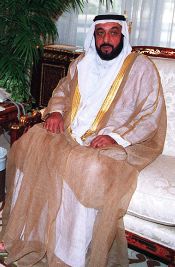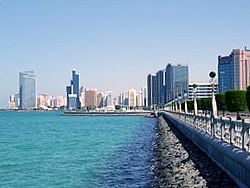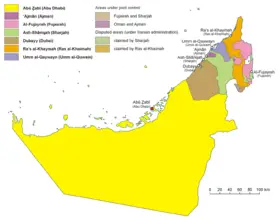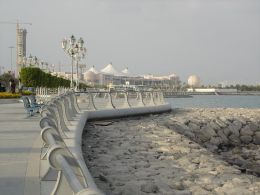Abu Dhabi (emirate)
| Abu Dhabi أبو ظبي |
|||
| — emirate — | |||
| Emirate of Abu Dhabi | |||
| The corniche in Abu Dhabi city | |||
|
|||
| Location of the seat of the emirate of Abu Dhabi | |||
| Coordinates: 24°28′N 54°22′E | |||
|---|---|---|---|
| Country | United Arab Emirates (UAE) | ||
| Seat | Abu Dhabi | ||
| Subdivisions | Towns and villages
|
||
| Government | |||
| - Type | Constitutional monarchy | ||
| - Emir | Khalifa bin Zayed Al Nahyan | ||
Abu Dhabi, officially, the Emirate of Abu Dhabi, (Arabic: إمارة أبو ظبيّ) transliteration: imārat ābūw ẓ’ābīy, literally Father of Gazelle), is one of seven emirates that constitute the United Arab Emirates (UAE). It is the largest emirate by area, and second-largest by population (after Dubai)[1], accounting for approximately 86% of the total land area of the UAE. The seat of President of the United Arab Emirates of the emirate is in Abu Dhabi city, which also hosts many oil companies, foreign embassies and the federal cabinet. Abu Dhabi's US$ 100 billion economy (2006) accounts for over 60% of the total Gross Domestic Product (GDP) of the United Arab Emirates. [2] Al Ain is Abu Dhabi's second largest urban area with a population of 348,000 (2003 census estimate) and is located 150 kilometres inland.
Geography
The emirate of Abu Dhabi is located in the oil-rich and strategic United Arab Emirates and is an active member of the Gulf Co-operation Council (GCC). It borders with the Kingdom of Saudi Arabia to its south and the Sultanate of Oman to its east. The emirate borders the emirate of Dubai to its northeast, surrounding half that state's territory, and has a short frontier with Al-Shariqah. In the north is the Persian Gulf.
With an area of 28,210 square miles (73,060 sq km) [3], it is unquestionably the largest of the UAE's seven constituent emirates, covering in excess of 75 percent of the entire country. The emirate has oil rich fields, both onshore and in the Persian Gulf. Along with Dubai, it leads the UAE in prosperity.
Abu Dhabi has 280 miles (450 km) of coastline on the the Persian Gulf. The coast is somewhat desolate, with many areas of salt marsh. There are numerous offshore islands. The emirate's main city, also called Abu Dhabi (with "city" often added to distinguish the two) is located on one of these islands, less than one quarter-kilometer from the mainland and joined to the mainland by the Maqta and Mussafah Bridges. Most of Abu Dhabi city is located on the island itself, but it has many suburbs on the mainland, such as the Khalifa Cities, Between Two Bridges, Mussafah Residential and more.
Climate
The emirate has a sunny climate, though the summer months of June through September are generally hot and humid with temperatures averaging above 40°C (110°F). During this time, sandstorms also occur intermittently, in some cases reducing visibility down to a few meters. The weather is usually pleasant from October to May. January to February is cooler and may require the use of a light jacket. This period also sees dense fog on some days.
The oasis city of Al Ain on the Oman border, regularly records the highest summer temperatures in the country, however the dry desert air and cooler evenings make it a traditional retreat from the intense summer heat and year round humidity of the capital city.
History
Parts of Abu Dhabi were settled as early as the 3rd millennium B.C.E. and its early history fits the nomadic herding and fishing pattern typical of the broader region.
Modern Abu Dhabi traces its origins to the rise of an important tribal confederation, the Bani Yas, in the late 18th century, which also assumed control of Dubai. In the 19th century the Dubai and Abu Dhabi branches parted ways. The Al Nahyan branch of Al Falahi is the ruling family in Abu Dhabi, while the Al Maktoum, a branch of Al Falasi, rules Dubai. Both stem from Bani Yas, which has an additional 13 main branches.
Into the mid-20th century, the economy of Abu Dhabi continued to be sustained mainly by camel herding, production of dates and vegetables at the inland oases of Al Ain and Liwa, and fishing and pearl diving off the coast of Abu Dhabi city, which was occupied mainly during the summer months. Most dwellings in Abu Dhabi city were, at this time, constructed of palm fronds (barasti), with the wealthier families occupying mud huts. The growth of the cultured pearl industry in the first half of the twentieth century created hardship for residents of Abu Dhabi since natural pearls represented the largest export and main source of cash earnings.
In 1939, Sheikh Shakhbut Bin-Sultan Al Nahyan granted petroleum concessions, and oil was first found in 1958. At first, oil money had a marginal impact. A few lowrise concrete buildings were erected, and the first paved road was completed in 1961, but Sheikh Shakbut, uncertain whether the new oil royalties would last, took a cautious approach, preferring to save the revenue rather than investing it in development. His brother, Zayed bin Sultan Al Nahyan, saw that oil wealth had the potential to transform Abu Dhabi. The ruling Al Nahyan family decided that Sheikh Zayed should replace his brother as ruler and carry out his vision of developing the country. On August 6, 1966, with the assistance of the British, Sheikh Zayed became the new ruler. [4]
With the announcement by the United Kingdom in 1968 that it would withdraw from the Persian Gulf area by 1971, Sheikh Zayed became the main driving force behind the formation of the United Arab Emirates. Together with the other Trucial States, Bahrain, and Qatar, Abu Dhabi negotiated the formation of a nine-member federation. However, Bahrain and Qatar both went on to separate independent status. The United Arab Emirates came into being with seven states, with Abu Dhabi becoming a leading member. Abu Dhabi city became the provisional capital of the UAE; its status was extended several times until it was made the permanent national capital in the early 1990s. [3]
Oil wealth continued to flow to the area and traditional mud-brick huts were rapidly replaced with banks, boutiques and modern highrises.
Government and politics

When the UAE was formed in 1971, the rulers of the individual emirates agreed upon and formed a system that would utilize modern administration, yet retain the traditional forms of government. This has allowed a distinct national identity to form, through consolidation of their federal status. The country enjoys an enviable degree of political stability. [5]
The traditional form of tribal administration is, in a sense, a form of direct democracyy, as the ruler can stay in power only as long as he is able to retain the support of the people. An unwritten but strong principle within the traditional rule is that the people should have free access to their sheikh. He is to hold frequent and open councils, allowing fellow tribesmen to voice their opinions. [5] Rapid modernization, enormous strides in education, and the influx of a large foreign population have changed society but have not altered the traditional political system.
Local government
Under the provisional constitution of 1971, each emirate reserves considerable powers, including control over mineral rights (notably oil) and revenues. In this milieu, federal powers have developed slowly. Each emirate also has representatives on the Federal National Council (FNC), the number of which is determined on the basis of their population.
Abu Dhabi's own central governing organ, the Executive Council, is chaired by the Crown Prince, Sheikh Mohammed bin Zayed Al Nahyan. Under the executive council are a number of separate departments, equivalent to ministries. A number of autonomous agencies, such as the Environmental Agency also exist, with clearly specified powers. The emirate is divided into two regions, the Western Region and the Eastern Region, headed by Ruler's Representatives, and there is also a Ruler's Representative on the important oil terminal island of Das. The main cities, Abu Dhabi and Al Ain, are administered by municipalities, each of which has a nominated municipal council, these coming under the Department of Municipalities and Agriculture, while a new municipal authority has been created for the Western Region. [5]
Federal government
The federal system of government includes a Supreme Council, a Cabinet, or Council of Ministers, a parliamentary body, the Federal National Council, and an independent judiciary, at the apex of which is the Federal Supreme Court.
During their initial discussions on forming a federation, the rulers of the seven emirates agreed that each of them would be a member of a Supreme Council, the top policy-making body in the new state and that they would elect a President and a Vice President from amongst their number, to serve for a five-year, renewable, term of office.
Abu Dhabi's representatives in the national government are Supreme Council Member - HH President Sheikh Khalifa bin Zayed Al Nahyan, Ruler of Abu Dhabi; and Crown Princes - HH General Sheikh Mohammed bin Zayed Al Nahyan, Crown Prince of Abu Dhabi and Deputy Supreme Commander of the UAE Armed Forces, Chairman of Abu Dhabi Executive Council. [5]
Although unofficial, the presidency of UAE is in fact hereditary to the Al-Nahyan clan of Abu Dhabi, and the premiership is hereditary to the Al-Maktoom clan of Dubai. The supreme council also elects the Council of Ministers.
economy
http://en.wikipedia.org/wiki/Abu_Dhabi_Investment_Authority
Language and literature
The majority of the inhabitants of Abu Dhabi are expatriate workers and professionals from India, Pakistan, Egypt, Bangladesh, Philippines, the United Kingdom, and elsewhere. English, Urdu are widely spoken.
The native-born population are Arabic-speaking Gulf Arabs who are part of a clan-based society. The Al Nahyan family, part of the al-Falah branch of the Bani Yas tribe, rules the emirate and has a central place in society.
Towns and cities
Abu Dhabi city is a modern city with broad boulevards, tall office and apartment buildings, and busy shops.
Other urban centers in the Abu Dhabi emirate are Al 'Ain, Baniyas and Ruwais. Al Ain is an agglomeration of several villages scattered around a valuable desert oasis; today it is the site of the national university, UAEU. Al Ain is billed as the Garden City of the UAE. Other work includes the 1st prize international competition of the Abu Dhabi Library and Cultural Center won by the Architects Collaborative, designed by Hisham N. Ashkouri of Boston, Massachusetts and New York, NY.
Transport
Abu Dhabi International Airport (AUH) and Al Ain International Airport (AAN) serves the emirate. The local time is GMT + 4 hours. Private vehicles and taxis are the primary means of transportation in the city, although public buses, run by the Abu Dhabi Municipality, are available, but mostly used by the lower-income population. There are bus routes to nearby towns such as Baniyas, Habashan and the garden city of UAE Al Ain, among others. There is a newer service started in 2005 between Abu Dhabi and the commercial city of Dubai (about 160 km away)
Culture and the arts
Abu Dhabi is home to a number of cultural institutions including the Cultural Foundation and the National Theater. The Cultural foundation is home to the UAE Public Library and Cultural Center. Various cultural societies such as the Abu Dhabi Classical Music Society have a strong and visible following in the city.
- Progress on the creation of a major "up-scale cultural district" on Abu Dhabi's Saadiyat Island has begun with the groundwork for a $400 million Guggenheim Museum. The Frank Gehry designed museum will display a "prestige collection" of modernist and contemporary art and is scheduled for completion in 2011. Upon completion, it is expected to be the largest exponent of the prestigious Guggenheim Museums.
- The island development will also include museums for classical art and performing arts centers among other state-of-the-art cultural facilities.
- $28 billion has been set aside to budget this cultural development.
Schools and universities
Schools and universities in Abu Dhabi:
- INDIAN ISLAHI ISLAMIC SCHOOL
- AL-NOOR INDIAN ISLAMIC SCHOOL
- Masdar Institute of Science and Technology (research oriented graduate-level university)
- Abu Dhabi Men's College (a campus of The Higher Colleges of Technology)
- Abu Dhabi Women's College (a campus of The Higher Colleges of Technology)
- The American International School in Abu Dhabi
- Zayed University
- New York Institute of Technology
- Abu Dhabi University
- International School of Choueifat, Abu Dhabi
- Sheikh Khalifa Bin Zayed Bangladesh Islamia School and College , Abu Dhabi
- Sheikh Khalifa Bin Zayed Arab Pakistani School (Kindergarten through 12th grade FSC)
- Islamia English School (Kindergarten through 12th grade FSC, IGCSE : O' Levels and A Levels also offered)
- Al Nahda National Schools (Boys and Girl's school O'Levels, A'Levels, American High school system)
- The Cambridge High School
- The British School - Al Khubairat
- Abu Dhabi Grammar School (Canada)
- Abu Dhabi International School
- First Steps School Nursery
- International Community School
- Our Own English High School
- The American Community School of Abu Dhabi
- The British School
- Abu Dhabi Indian School
ReferencesISBN links support NWE through referral fees
- ↑ Abu Dhabi - profile of geographical entity including name variants. World Gazetteer. Retrieved April 8, 2008
- ↑ Abu Dhabi GDP likely to touch Dh584b by '10. The Gulf Today. March 11, 2007.
- ↑ 3.0 3.1 Encyclopædia Britannica Online. 2008. Abu Zaby Retrieved May 14, 2008.
- ↑ Al Fahim, Mohammed. 1995. From rags to riches: a story of Abu Dhabi. London: London Centre of Arab Studies. ISBN 1900404001
- ↑ 5.0 5.1 5.2 5.3 UA Interact. UA Government - Political system Retrieved May 14, 2008.
External links
- Travel guide to Abu Dhabi from Wikitravel
- Abu Dhabi Police
- Abu Dhabi's entry in the Encyclopaedia of Postal History
- Abu Dhabi Chamber of Commerce and Industry
- Abu Dhabi National Oil Company
- ADIAS, Abu Dhabi Islands Archaeological Survey
- Time Out Abu Dhabi, guide to life in Abu Dhabi
- National Bank of Abu Dhabi
- Abu Dhabi Photos
U.A.E. based News Papers
Non-Government Organisations
- Ansar Burney Trust - human rights and anti-slavery organisation
Credits
New World Encyclopedia writers and editors rewrote and completed the Wikipedia article in accordance with New World Encyclopedia standards. This article abides by terms of the Creative Commons CC-by-sa 3.0 License (CC-by-sa), which may be used and disseminated with proper attribution. Credit is due under the terms of this license that can reference both the New World Encyclopedia contributors and the selfless volunteer contributors of the Wikimedia Foundation. To cite this article click here for a list of acceptable citing formats.The history of earlier contributions by wikipedians is accessible to researchers here:
The history of this article since it was imported to New World Encyclopedia:
Note: Some restrictions may apply to use of individual images which are separately licensed.




